【WPF】Slider、ToolBar
ToolBar结构

设置了最大值是10,上下的Tick指针都显示,间隔是1。
上图从上往下分析一下结构就是:上TickBar + 包含Thumb、RepeatButton的Track + 下TickBar,即

MSDN上面是这样的:
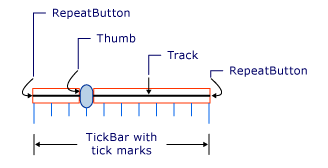
RepeatButton就是点击Thumb两侧空白(实际是RepeatButton背景色是透明色)的实现移动Thumb的效果。
对许多小的按钮(或者其他控件)进行分组。
ToolBar 可以被放在元素树的任何地方,但是通常把它们放在一个叫作ToolBarTray 的FrameworkElement 中。
用户就可以拖曳ToolBar 或重新定义ToolBar,。除非ToolBarTray的IsLocked 属性被设置为true。
ToolBarTray 有一个Orientation 属性,可以把它设置为Vertical 使其所有的ToolBar 垂直排列项。
默认都是最后一个元素第一个被移到溢出区域,但是你能通过OverflowMode 附加属性来控制每个项的溢出行为。有了这个属性,你就可以把一个项标记为AsNeeded(默认,按需要溢出)、Always 或Never。
System.Windows.Input 命名空间中的KeyboardNavigat ion 类定义了一些用来自定义键盘行为的附加属性。
ToolBar 实际上是一个带有头的Item 控件(就像MenuItem 和TreeViewItem)。它的Header 属性从来不会被显示,但是它可以被用来实现ToolBarTray 的其他特性。。
slider控件value值默认为Double类型,让其为整数方式:
IsSnapToTickEnabled: issnaptotickenabled=“true” 以刻度线对齐,该值指示Slider是否自动将Thumb移动到最近的刻度线。
TickFrequency="1":刻度 频率
TickPlacement="BottomRight" 设置刻度线出线在滚动条的那边, 刻度显示在滑动条下方
Fill="DarkMagenta" 刻度线的颜色
ToolBarTray
ToolBarTray是ToolBar的容器,ToolBar可以放在任何地方,通常放在ToolBarTray中。ToolBarTray 将处理诸如放置和调整大小之类的事情,并且您可以在 ToolBarTray 元素内拥有多个 ToolBar 控件。
<Window x:Class="WpfTutorialSamples.Common_interface_controls.ToolbarSample" xmlns="http://schemas.microsoft.com/winfx/2006/xaml/presentation" xmlns:x="http://schemas.microsoft.com/winfx/2006/xaml" Title="ToolbarSample" Height="200" Width="300"> <Window.CommandBindings> <CommandBinding Command="New" CanExecute="CommonCommandBinding_CanExecute" /> <CommandBinding Command="Open" CanExecute="CommonCommandBinding_CanExecute" /> <CommandBinding Command="Save" CanExecute="CommonCommandBinding_CanExecute" /> </Window.CommandBindings> <DockPanel> <ToolBarTray DockPanel.Dock="Top"> <ToolBar> <Button Command="New" Content="New" /> <Button Command="Open" Content="Open" /> <Button Command="Save" Content="Save" /> </ToolBar> <ToolBar> <Button Command="Cut" Content="Cut" /> <Button Command="Copy" Content="Copy" /> <Button Command="Paste" Content="Paste" /> </ToolBar> </ToolBarTray> <TextBox AcceptsReturn="True" /> </DockPanel> </Window>
效果
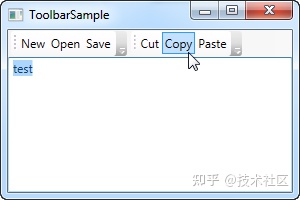
图标
虽然工具栏按钮上的文本完全可以,但通常的方法是使用图标或至少是图标和一段文本的组合。由于 WPF 使用常规 Button 控件,因此向工具栏项添加图标非常容易。看看下一个例子,我们都做:
<Window x:Class="WpfTutorialSamples.Common_interface_controls.ToolbarIconSample" xmlns="http://schemas.microsoft.com/winfx/2006/xaml/presentation" xmlns:x="http://schemas.microsoft.com/winfx/2006/xaml" Title="ToolbarIconSample" Height="200" Width="300"> <DockPanel> <ToolBarTray DockPanel.Dock="Top"> <ToolBar> <Button Command="Cut" ToolTip="Cut selection to Windows Clipboard."> <Image Source="/WpfTutorialSamples;component/Images/cut.png" /> </Button> <Button Command="Copy" ToolTip="Copy selection to Windows Clipboard."> <Image Source="/WpfTutorialSamples;component/Images/copy.png" /> </Button> <Button Command="Paste" ToolTip="Paste from Windows Clipboard."> <StackPanel Orientation="Horizontal"> <Image Source="/WpfTutorialSamples;component/Images/paste.png" /> <TextBlock Margin="3,0,0,0">Paste</TextBlock> </StackPanel> </Button> </ToolBar> </ToolBarTray> <TextBox AcceptsReturn="True" /> </DockPanel> </Window>
效果
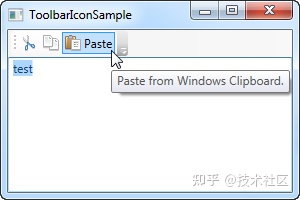
溢出
正如已经提到的,使用 ToolBar 控件而不仅仅是按钮面板的一个很好的理由是自动溢出处理。这意味着如果不再有足够的空间来显示工具栏上的所有按钮,WPF 会将它们放在一个菜单中,该菜单可通过单击工具栏右侧的箭头来访问。您可以在此屏幕截图上看到它是如何工作的,它显示了第一个示例,但窗口较小,从而为工具栏留下了较少的空间:
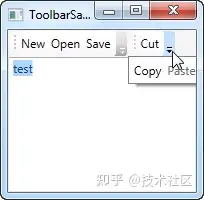
WPF 甚至允许您决定哪些项目适合溢出隐藏,哪些应该始终可见。通常,在设计工具栏时,有些项目不如其他项目重要,而有些项目您甚至可能希望一直显示在溢出菜单中,无论空间是否足够。
这是附加属性ToolBar.OverflowMode发挥作用的地方。默认值是 AsNeeded,这只是意味着如果没有足够的空间,则将工具栏项放入溢出菜单中。您可以使用Always或Never来代替,这正是名称所暗示的:始终将项目放在溢出菜单中或防止该项目被移动到溢出菜单。以下是有关如何分配
<ToolBar> <Button Command="Cut" Content="Cut" ToolBar.OverflowMode="Always" /> <Button Command="Copy" Content="Copy" ToolBar.OverflowMode="AsNeeded" /> <Button Command="Paste" Content="Paste" ToolBar.OverflowMode="Never" /> </ToolBar>
垂直
<ToolBarTray Orientation="Vertical"> <ToolBar IsOverflowOpen="True" Band="1" BandIndex="1" Background="SaddleBrown"> <RadioButton Cursor="Hand" Padding="8" Foreground="Wheat" Style="{DynamicResource RadioButtonStyle}" Height="60" IsThreeState="False"> <Path Stretch="Uniform" Fill="Aqua" Data="{StaticResource deleteIco}"/> </RadioButton> <RadioButton Padding="8" Cursor="Hand" Foreground="Wheat" Style="{DynamicResource RadioButtonStyle}" Height="60" IsChecked="{Binding IsAddSquare, Mode=TwoWay}" IsThreeState="False"> <Path Stretch="Uniform" Fill="Aqua" Data="{StaticResource addIco}"/> </RadioButton> <RadioButton Padding="8" Foreground="Wheat" Cursor="Hand" Style="{DynamicResource RadioButtonStyle}" Height="60" IsThreeState="False"> <Path Stretch="Uniform" Fill="Aqua" Data="{StaticResource SelectOrMoveIco}"/> </RadioButton> </ToolBar> </ToolBarTray>
效果
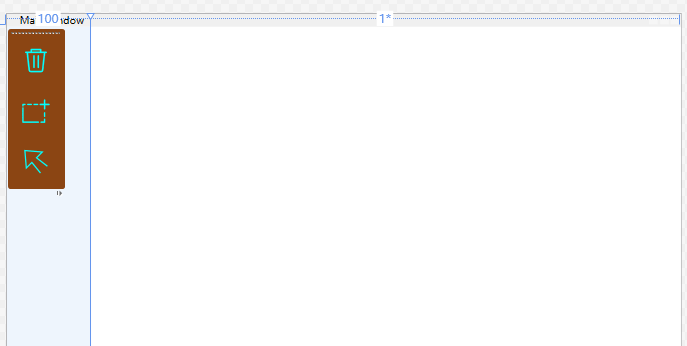
ToolBar分隔符
<Window x:Class="菜单.MainWindow" xmlns="http://schemas.microsoft.com/winfx/2006/xaml/presentation" xmlns:x="http://schemas.microsoft.com/winfx/2006/xaml" xmlns:d="http://schemas.microsoft.com/expression/blend/2008" xmlns:mc="http://schemas.openxmlformats.org/markup-compatibility/2006" xmlns:local="clr-namespace:菜单" mc:Ignorable="d" Title="MainWindow" Height="200" Width="300"> <Window.CommandBindings> <CommandBinding Command="New" CanExecute="CommonCommandBinding_CanExecute" /> <CommandBinding Command="Open" CanExecute="CommonCommandBinding_CanExecute" /> <CommandBinding Command="Save" CanExecute="CommonCommandBinding_CanExecute" /> </Window.CommandBindings> <DockPanel> <ToolBarTray DockPanel.Dock="Top"> <ToolBar> <Button Command="New" Content="New" /> <Button Command="Open" Content="Open" /> <Button Command="Save" Content="Save" /> <Separator /> <Label>Font size:</Label> </ToolBar> <ToolBar> <ComboBox> <ComboBoxItem>10</ComboBoxItem> <ComboBoxItem IsSelected="True">12</ComboBoxItem> <ComboBoxItem>14</ComboBoxItem> <ComboBoxItem>16</ComboBoxItem> </ComboBox> </ToolBar> </ToolBarTray> <TextBox AcceptsReturn="True" /> </DockPanel> </Window>
以上示例还在toolbar中放了分隔符,lable以及combobox控件 TickBar
重新设计Slider
<Style x:Key="DefaultSliderStyle" TargetType="Slider" BasedOn="{StaticResource BaseSliderStyle}"> <Setter Property="Template"> <Setter.Value> <ControlTemplate TargetType="Slider"> <Grid> <Grid.RowDefinitions> <RowDefinition Height="Auto"/> <RowDefinition Height="Auto"/> <RowDefinition Height="Auto"/> </Grid.RowDefinitions> <TickBar Name="TopTick" Grid.Row="0" Placement="Top" Height="4" Visibility="Visible" Fill="Red"/> <Border Name="TrackBackground" Grid.Row="1" Height="4" Background="Green"/> <Track Name="PART_Track" Grid.Row="1"> <Track.DecreaseRepeatButton> <RepeatButton Style="{StaticResource DefaultRepeatButtonStyle}" Command="Slider.DecreaseLarge"/> </Track.DecreaseRepeatButton> <Track.Thumb> <Thumb Style="{StaticResource DefaultSliderThumbStyle}"/> </Track.Thumb> <Track.IncreaseRepeatButton> <RepeatButton Style="{StaticResource DefaultRepeatButtonStyle}" Command="Slider.IncreaseLarge"/> </Track.IncreaseRepeatButton> </Track> <TickBar Name="BottomTick" Grid.Row="2" Placement="Bottom" Height="4" Visibility="Visible" Fill="Red"/> </Grid> </ControlTemplate> </Setter.Value> </Setter> </Style>
模板包括三行,分别放上TickBar、Track、下TickBar
1、用一个Border做背景色;
2、TickBar都设置了可见(为了演示),一开始可设置都不可见;然后添加Trigger,判断TickPlacement的值取设置那个可见;
3、Thumb 是一个圆形按钮;
4、RepeatButton设置成透明;
5、Track的Name一定要设置为PART_Track,不然就不能拖动Thumb了。(在其他地方看到的解释了,微软写内部模板,这类命名方式不能改,个人经验是类似PART_XXX这类名称。)
Thumb的样式是,一个圆:
<Style x:Key="DefaultSliderThumbStyle" TargetType="Thumb"> <Setter Property="Width" Value="15"/> <Setter Property="Height" Value="15"/> <Setter Property="Background" Value="Blue"/> <Setter Property="SnapsToDevicePixels" Value="True"/> <Setter Property="Template"> <Setter.Value> <ControlTemplate TargetType="Thumb"> <Ellipse Width="{TemplateBinding Width}" Height="{TemplateBinding Height}" Fill="{TemplateBinding Background}"/> </ControlTemplate> </Setter.Value> </Setter> </Style>
RepeateButton透明:
<Style x:Key="DefaultRepeatButtonStyle" TargetType="RepeatButton"> <Setter Property="Template"> <Setter.Value> <ControlTemplate TargetType="RepeatButton"> <Border Background="Transparent"/> </ControlTemplate> </Setter.Value> </Setter> </Style>







【推荐】国内首个AI IDE,深度理解中文开发场景,立即下载体验Trae
【推荐】编程新体验,更懂你的AI,立即体验豆包MarsCode编程助手
【推荐】抖音旗下AI助手豆包,你的智能百科全书,全免费不限次数
【推荐】轻量又高性能的 SSH 工具 IShell:AI 加持,快人一步
· 分享一个免费、快速、无限量使用的满血 DeepSeek R1 模型,支持深度思考和联网搜索!
· 基于 Docker 搭建 FRP 内网穿透开源项目(很简单哒)
· ollama系列01:轻松3步本地部署deepseek,普通电脑可用
· 25岁的心里话
· 按钮权限的设计及实现